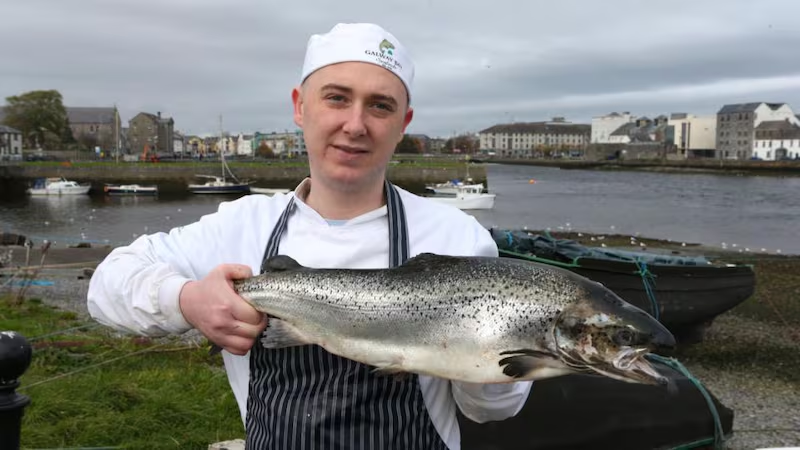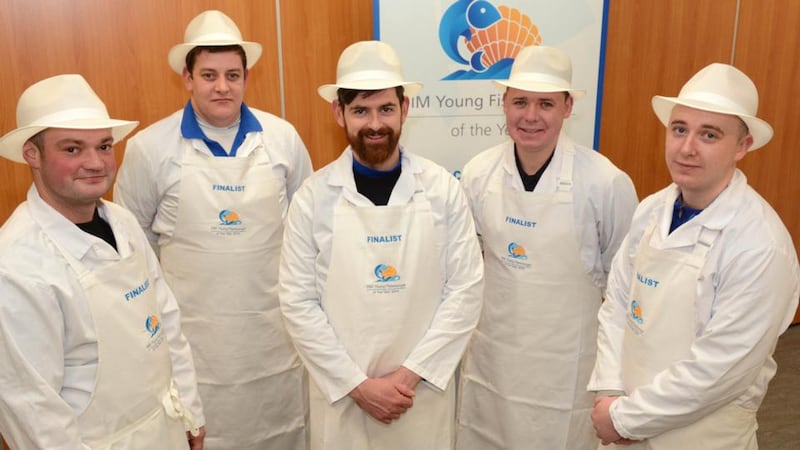It might be the beard, but Graham Rogerson looks like a web designer or a new media expert, or some other profession that didn’t exist a generation ago. Yet his job is more timeless. Standing in apron and whites, he lifts a glassy-eyed hake from a shallow tank in a table. He steadies the slippery body with one hand. Then he slices the head off. Next he cuts along the length of the fish opening the flesh like a large book and slicing one half cleanly away from the bone. The second half is trickier, extracting the spine. The head, tail and spine slap into a crate at his feet and he has two white fillets ready to be sold.
Rogerson is a fishmonger. He's one of five finalists in a Bord Iascaigh Mhara (BIM) young fishmonger competition, the winner of which will be announced on Monday. He used to work in a bank (a different kind of filleting operation, perhaps). His sister Lisa, used to work in recruitment. Then four years ago they decided to open a fish shop together in Monkstown, south Dublin, continuing a family business that goes back to his grandfather.
After years in decline, fishmongering is growing in Ireland and the five young men are part of a wave of new blood into the trade. Irish consumers are eating more fresh fish, with sales up 8 per cent last year compared to 2011. Numbers in the trade are rising to the level of over a century ago. The 1911 Census lists 226 fishmongers in Ireland and a further 905 fish dealers, mostly women, living in port or seaside areas. According to BIM there are roughly 500 fish counters in country today, including fish shops and supermarket fish counters, each one run by at least one fishmonger. BIM gets calls “on a weekly basis from people wishing to set up a fish shop”, a spokesperson said.


At George’s Fish Shop in Monkstown (George is Lisa’s and Graham’s father) there’s a brisk Friday morning trade. They buy much of their fish from boats in Kilmore Quay. “Can I put it in the freezer?” one customer asks. By far the most common question, Rogerson says, is, “How do I cook it?”
Do his friends slag him about his job? “Maybe when I was 10 or even five they did, but younger people are eating a lot more fish. Even teenagers are very health conscious.” He’d like to persuade people that lesser-known species like flounder and pollock are delicious and cheap.
Another George, George Stephens junior (30) is the third in a line of Georges, but he’s the first fishmonger in the family. “I was a chef for 10 years.” He worked with Derry Clarke and in the kitchen at Sheen Falls Lodge, always opting for the fish section if he could. In the search for a more family-friendly job in food, he opened his first fish shop in Mullingar, his home town, in September 2008 “just before the banking guarantee” he remembers grimly. He credits restaurateur and TV chef Martin Shanahan as a mentor who gave him a lot of help setting up the new venture.
Stephens spent six months researching the market and got a list of contacts from Martin McLoughlin, of Nicky’s Plaice, on the pier in Howth. The reaction to the shop in Mullingar was instantly “very good”, he says. People welcomed an alternative to supermarket fish. He makes 5am trips to the fish market on Tuesdays, Thursdays and Fridays and everything he buys is typically sold within 36 hours. He has three young men working with him now, and has opened a second shop in Maynooth. Two of his fishmongers are former chefs and one is a former priest. “We joke that he went from working with real souls to black soles.”
Like his mentor, he is fanatical about fish. “It really is the tastiest food. We eat fish constantly at home. We’d just take a piece of salmon, do it with noodles and veg and a teriyaki sauce.”
James Kirwan (31) was fishing on boats as a teenager, working on trawlers out of Clogherhead in Louth and Greencastle and Killybegs in Donegal. His job took him from Dingle to the Azores and the Bay of Biscay. There was a yearning yo-yo quality to life as a fisherman. “When you’re at sea all you want to be is away from it and when you’re away all you want to do is be back at sea.” He decided to find a job ashore when he was working out of Dingle. Costs were rising. They could burn through €4,000 worth of diesel in a day’s fishing, he says. And he had “a woman” back at home. So he came ashore to work with his father as a mechanic but found he didn’t like the work.
So he approached his uncle, who was a fishmonger, and asked him to train him. Then he opened his fish shop, East Coast Seafood, in a business park in Naas. He finds it enormously satisfying dealing with customers. “You try not to just sell people fish. You try to build a relationship, try not to just be a shop.” As a former fisherman, he knows by the name of the boat that landed the fish, how fresh it is. The fresher it is, the more translucent the glow of its skin, a difficult thing to assess when you’re buying skin-side down fish under clingfilm in a supermarket. If the fish is whole, the “eyes are a dead giveaway,” Kirwan explains. Clear and glassy means the fish is fresh. Cloudy means it’s been much longer since it was alive.
He loves to cook fish and his favourite dish is brill topped with breadcrumbs, pine nuts and melted butter with some grated Parmesan, baked in the oven.
Frenchman Arnaud Lepricey (32) came to Ireland more than 10 years ago to improve his English. “I dreamed I was a fishmonger,” he says, and as a teenager in France he went to the market and got himself a job in an open fish market. Arriving in Dublin, two Swedish women told him Howth was the place for fish shops and he left a CV in before landing a job in Wrights.
He enjoys the art of arranging his fish counter every morning, playing with colours. Seeing his customers face-to-face is another pleasure and he would love to see an open fish market in Dublin. Would he recommend it as a career? “It’s a hard job. You really have to love the job. It’s cold and some people don’t like handling fish.” But for him it’s a job that keeps him “in touch with nature all the time”.
In Galway, John Feeney (24) was working in carpentry when he decided to try his hand at fishmongering over two years ago. He was trained on the job at Galway Bay Seafoods in filleting, scaling and pin-boning. He also learned how to hot-smoke salmon, mackerel, haddock and coley, and still works for the same company.
New customers need some help when they first come in, he finds. They want to get ideas on how to cook something, and get an “easy” fish to start. Feeney recommends cod, floured and then pan-fried for a few minutes, or cooked in tinfoil with lemon and butter. Mackerel is one of his favourites. “We’ll always offer to take out the bones.” He finds he’s learning things every day, the challenge of filleting different species. And he also believes the cheapest fish are some of the best. “Mackerel and whiting are really great value and they’re beautiful.”
From the busy Friday morning trade in George’s Fish Shop in Monkstown, you can see that we still have a fish-on-Friday attitude. But it’s obvious from growing sales and the appearance of new fish shops in cities and towns that consumers are beginning to see fish as a pleasure rather than a penance.











